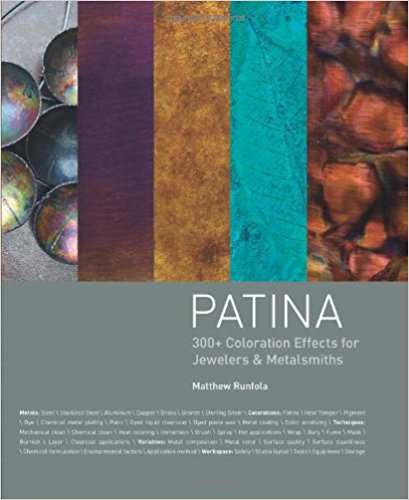Thanks, John.
Will the patinas in that book work on regular copper + tin bronze?
They are specifically for bronze but saying that, as far as I know, the majority of reactions are taking place with the copper. Trial and error is most often called for. Tin bronze (Ancient Bronze) will react but the colors are often a bit different, again experimentation is what works best here. Even different people using the same patina on the same alloy get different colorations, differences in heat on/in the piece, exactly how they apply it (wetter/drier), their karma…… One companies Everdur alloy can react a bit differently than a different companies alloy, again, small variations of “contaminants” (other trace metals) can make small differences.
I get mine from Rio Grande. I also use other base metals and various silvers (sterling, argentium, fine). Keeping all the different brasses straight is a chore sometimes, but necessary.
Yes it can be but that is one part of patination/metal coloration that makes it unique to the artist.
I make small pieces and jewelry, so not anything I’d call sculptures.
The biggest problem you might have is keeping the small pieces evenly heated and maintaining that temperature for the total time needed to get the coloration done. With bigger bronzes, maintaining the heat one wants can be easier but even on sculptures, extremities, especially fingers and wing tips want to cool far faster that than the “body” of a piece. You get a feel for this and how to deal with it but it does raise it’s head at times and gives one problems. One reason there are folks who just do patination, it is an art, it is technical and there are a LOT of potential variations.
I’ve seen a number of the recipes in the Hughes & Rowe book in other places as well, so I’ll take notes as I go. (One never knows if the recipe is tried-and-true, or just being repeated from the same source.) The black triangle ones are off the table for me, and I’m starting with the more common ones, so I hope I can see some results.
Still, not sure about the drying process. I’ll keep researching it.
If you are after browns or blacks, I would HIGHLY recommend you at least give the Selenic acid (Birchwood Casey patinas). You can get these from Sculpt Nouveau and again, I would e mail or call them as have a bit of a discussion about what you are wanting to do. The B.C. products are cold patinas so one gets around the heating problems. With small pieces, you can use a small brush and make areas darker (more “washes” with a weaker solution) so you can get, with practice, shading that can be really nice.
Patination is a vast area of trial and error, making your own chemistries at times/as needed (my homemade ferric nitrate is VERY different from the “chemically concocted” materials, giving vastly broader colorations, more reds and on and on, I use very old railroad spikes that we found way out in the “no where” years ago for the metal, with all the contaminants of older smelting processes and different ways they made steels back then verses today). Probably more than mose would ever want to know or hear about.
Good luck and again questions, thoughts, comments are most welcomed.
john
.

 ) so I may end up going in that direction.
) so I may end up going in that direction. Very happy.
Very happy.